This report is prompted by reader requests to look into modern concealed-carry holsters. Some of them are relatively inexpensive, but others are much more expensive. While it isn’t a completely bad idea to purchase a cheap generic holster to get the hang of IWB, appendix, or crossdraw carry, a holster properly chosen may last for several years to a decade. They are not a lifetime investment like a quality firearm is. Holsters are a renewable resource that must be replaced from time to time. And like a handgun, there may be times when one holster will not solve every problem, particularly if you live in a true four-season climate. A belt scabbard and an IWB may cover most of your needs, and in some cases combination holsters, such as the Galco Corvus tested below, do an admirable job at several chores.
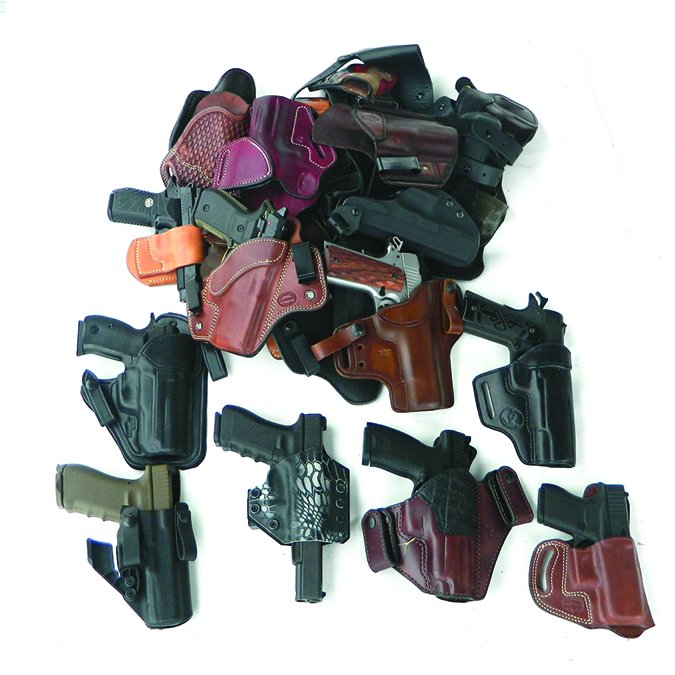
For this test, we choose holsters for the Glock 43, a single-column-magazine 9mm that seems to be a popular carry gun. We also included the Smith & Wesson Shield and larger Glock handguns. We do not rely upon smaller handguns for carry, and our raters, a mix of military, police, and university-level instructors in this case, do not deploy handguns smaller than 9mm caliber. The Glock 43, Glock 17, and Smith & Wesson Shield 45 ACP were the handguns tested.
Also, the reader request included a suggestion to test modern appendix holsters. Appendix carry occurs near the front of the belt and to one side of the belt buckle. This carry is controversial. Some point out the obvious danger of an accidental discharge resulting in immediate removal of pretty important gear from the shooter’s front side. Women have a more complex circulatory system in the same area and would also be subject to a terrible wound if shot in that area. If you are planning on having a negligent discharge with appendix or any other carry, then you need to rethink and retrain. But by observing safety practices and avoiding mistakes, you will not have a negligent discharge if you appendix carry.
Appendix carry may have the advantage of being discreet. When you bend or stoop, the holster and handgun carried in the small of the back, IWB style, may print against the clothing. Not so with appendix carry. You may get a shove in the body from the gun in appendix carry when bending, so be careful until you acclimate to the gun’s position. Also, we feel that for most of us, appendix carry is best suited to more compact handguns. The Government Model steel-frame 1911 one of our raters carries daily isn’t well suited to appendix carry due to its length. Another advantage is that when moving about in normal human interaction, an arm on the back may reveal the hard bulge of a handgun. Few people will be touching your firearm in the appendix position.
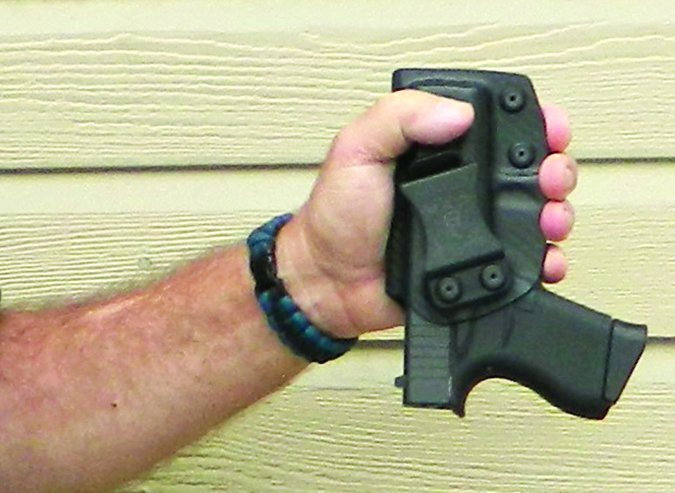
The holster must have a balance of speed, security, and access. It cannot be buried under the clothing to the extent that it is difficult to access. A very fast draw isn’t necessarily the main ingredient of a successful concealment rig. Good concealment that allows surprise is. Perhaps the adversary doesn’t know you are armed, and he should not. There should be no indicators that show you are armed.
Let’s look at reality. There is no draw faster than a standard belt holster carried on the point of the hip. This is also a holster that isn’t compatible with concealed carry. The holster must be worn behind the hip under a covering garment at the least, and for better concealment, we move the holster inside the pants, or inside the waistband fashion as we call it. You must practice the draw to clear clothing, and is a real danger when clothing becomes tangled. The appendix carry requires less movement. Also, during the course of the day, you sometimes encounter people who like to bump into you or perhaps give a friendly pat. Some know you are armed; most should not. If they pat the groin area, they probably know you pretty well.
There are also martial-arts advantages to the appendix carry. While many have criticized the crossdraw, as an example, for making the handgun available to the gun grabber, this isn’t true when the wearer is well trained and aware. When the handgun is worn toward the front, the gun grab will not be a surprise as much as a rearward originating attack and you have both hands, not one, to defend against the attack.
The most dangerous part of training is re-holstering a loaded firearm. Trigger discipline and understanding how a trigger may snag on the holster is important, no matter what style of holster you adopt. Here’s what we thought of several holsters in more detail:
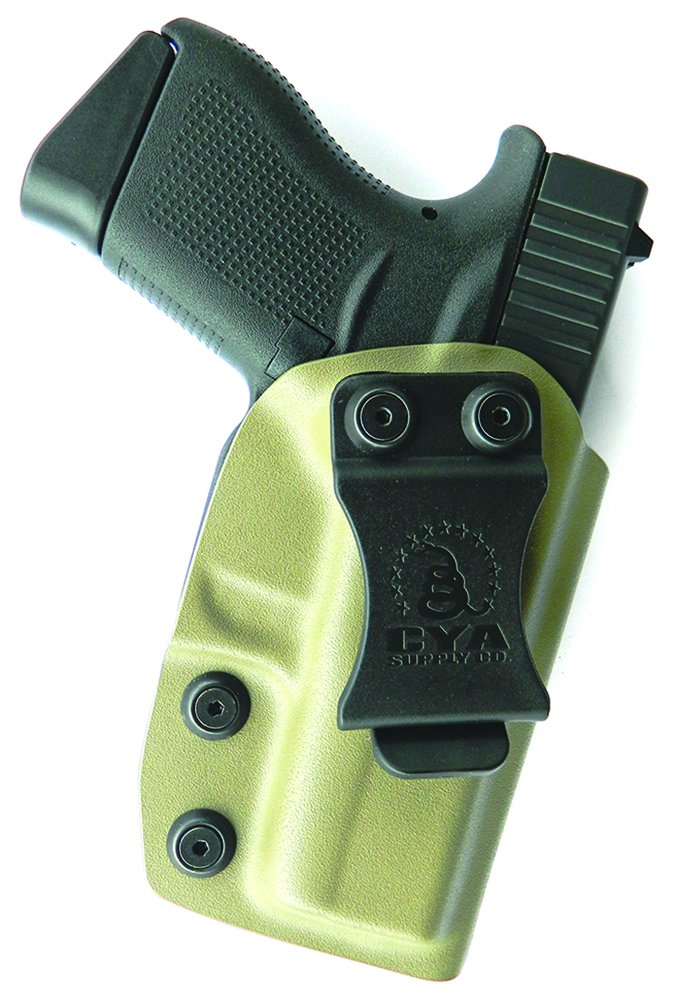
CYA IWB, $38
GUN TEST GRADE: A (BEST BUY)
This holster is available from CYASupply.com. The holster was tested in flat dark earth, carbon fiber, and black finish. This allowed three raters to test this holster independently. The holster is secure, providing the wearer uses a quality gun belt; the same is true with all the holsters. Retention is good. Ideally, the holster should demonstrate a good, tight fit that isn’t easily overcome with a slow draw but which is fast when a hard tug is given. The CYA holster performed in that manner. We held the holster and an unloaded gun upside down and shook the holster. Retention did not fail. The holster is provided with an Allen wrench to tighten the holster and adjust tension. It came out of the box properly set. Comfort is as good as any other holster. One rater had recently had a hernia operation and found that the holstered Glock 43 did not impede his movement. And, although skeptical at first, he found speed and access superior to the IWB holster he had worn behind the hip.
Galco Corvus, $64
GUN TEST GRADE: B
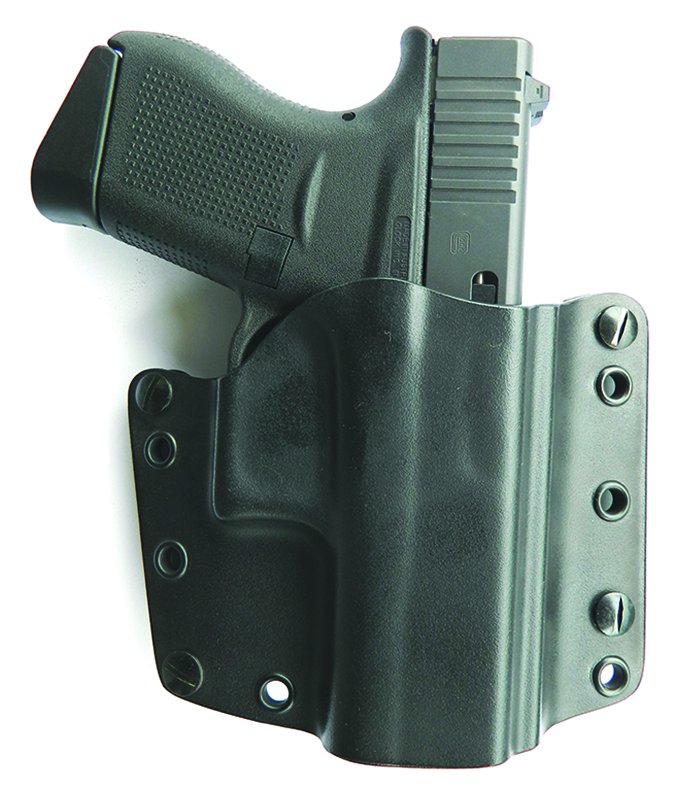
This holster is available from GalcoGunleather.com and also Brownells.com. The Corvus is supplied with two sets of belt loops (plastic) and a single set of IWB belt loops. When first examining the Corvus, we were not certain how the slight curve of the holster would feel in IWB carry. As it turns out, it hugs the curve of the hip very well. As an IWB unit, the holster is concealable and offers adjustment for ride, either deep in the trousers or higher above the belt line. The holster is versatile. As an appendix holster, we found that the dual belt loops actually offer better concealment than the single belt loop. The single position on the face of that type of holster extends a few tenths of an inch, but with the Corvus, the dual loops are flatter, although the width is greater. The draw and re-holstering were solid. The holster functions well as a strong-side holster with the belt loops firmly attached and may be concealed under a jacket or vest. The draw is faster when the holster is offset from the body in this manner. The only drawback came from the tests in which the triple-checked unloaded firearm was shaken upside down for retention. About one out of three tries resulted in the firearm being dropped on the padding we used to catch the firearm. When jumping in a standard IPSC test, it did not occur. We really like the versatility of the Corvus, but we rated it down a grade based on the retention.
Galco Triton IWB, $52
GUN TEST GRADE: A
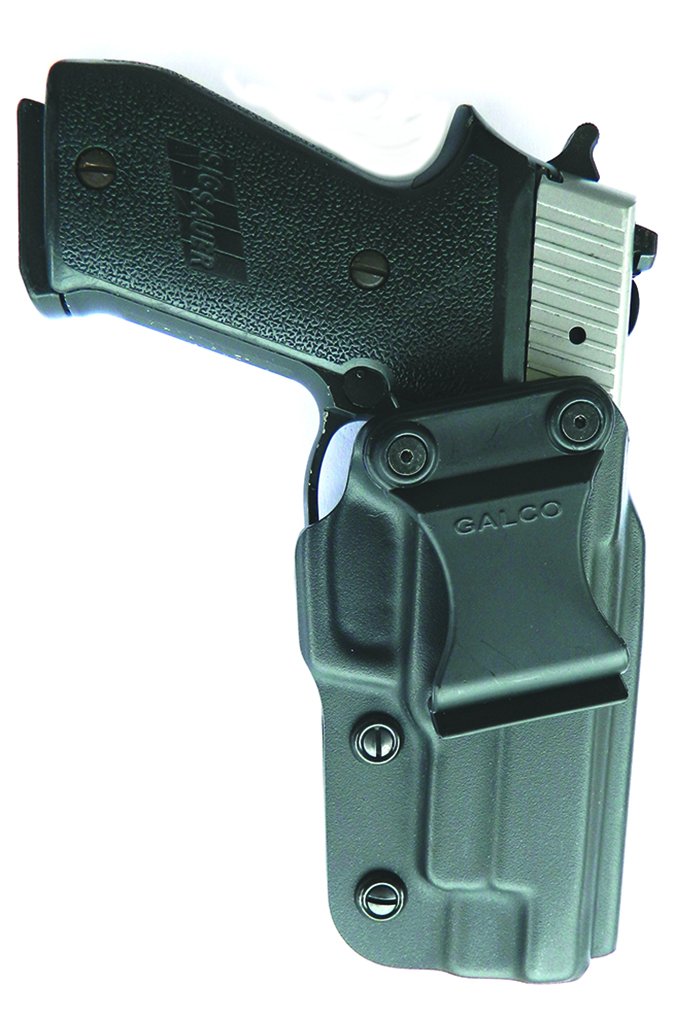
This was the price of our sample from Brownells.com. An advantage of the Triton is that this holster is often available at well-stocked super stores and is usually in stock and ready to ship at outlets such as Brownells.com. We ordered the Triton for the SIG P220R 45 ACP to evaluate the holster with a large handgun to test the viability of appendix carry with a heavy pistol. The Triton is designed as an IWB but worked well in the appendix role. Retention was excellent. In fact, we had to back off the adjustment screws for the ideal balance of speed and retention, and the holster maintained a firm grip during vigorous shaking upside down of this heavy P220. When wearing the Triton/SIG combination in the appendix position, the longer handgun was more likely to pinch than the Glock 43, but the holster itself gave a nudge rather than a punch in the gut.
The combination is reaching the limits of comfort, but for those who prefer the power and accuracy of a 45-caliber P220, it is a viable combination. The Triton is available for smaller and many other popular handguns.
GearCraft IWB Plus, $70
GUN TEST GRADE: A
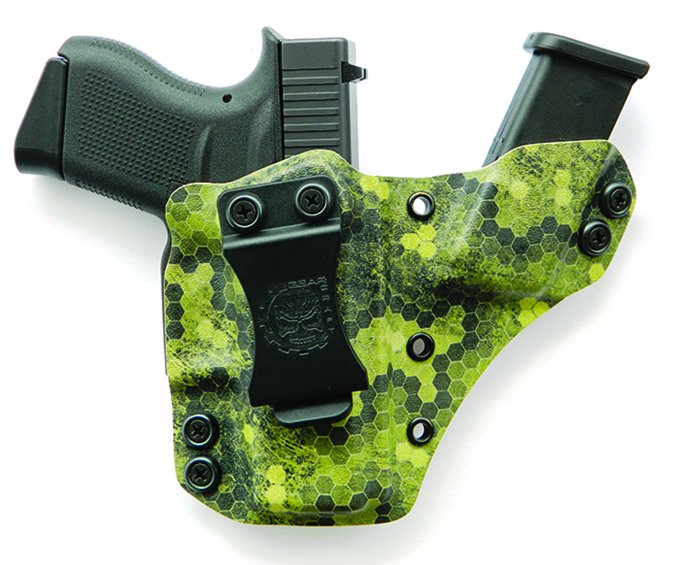
This item was available from GearCraftHolsters.com. One of our raters is normally resistant to holsters with the magazine pouch attached because the correct draw of the magazine is from the weak side. However, he reports that most of his students do not carry a spare magazine, and this holster goes a long way in encouraging all CWP holders to deploy a spare magazine. As delivered, the holster did not retain the handgun during the initial drop test, but a few turns of the retention screws cured that shortcoming. The holster rides comfortably in the appendix position. The balance of speed and retention is good. The magazine is angled toward the non-dominant hand for a rapid draw, something that isn’t possible with conventional IWB carry. We liked this holster very much. It is larger and wider than the others. If you carry the spare magazine in a dedicated pouch, do not choose this holster.
If you do not wish the holster to extend to the belt buckle, do not choose this holster. As a load-bearing device with the holster containing the handgun and the spare magazine in a single unit, it has much merit. A spare loaded magazine was subjected to the drop test with an empty handgun and both were retained.

GearCraft Quickie, $40
GUN TEST GRADE: B-
This item was available from GearCraftHolsters.com. The Quickie takes a single attachment point and moves it behind the trigger guard instead of on the face of the holster for good concealment. The belt attachment features a good hook. We had to tighten the Quickie to achieve acceptable retention; however, it still wasn’t as tight as we would like. It is fast, and body compression held the larger Glock pistols this holster is molded for (the G19/G23) in the holster along with proper molding. This is a holster best suited for IWB rather than appendix carry.
JM Custom Kydex AIWB with Wing Claw, $90
GUN TEST GRADE: A
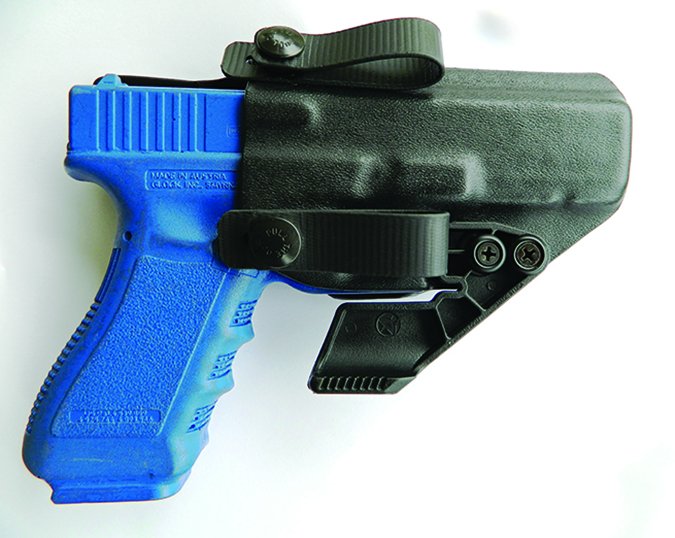
This item is available from JMCustomKydex.com. We ordered this holster for a rater’s personal Glock 22 carry gun. This holster is designed as an appendix holster. Removing the wing allows standard IWB carry. There are two holes on each side of the holster for the belt-loop attachment; this allows adjustment of the ride and cant of the holster. We found the balance of retention and speed to be ideal. The adjustment range is good. The draw is good and sharp. There is a Velcro component permanently attached to the back of the holster that adds to the comfort of the holster. The claw is an anti-roll-out device.
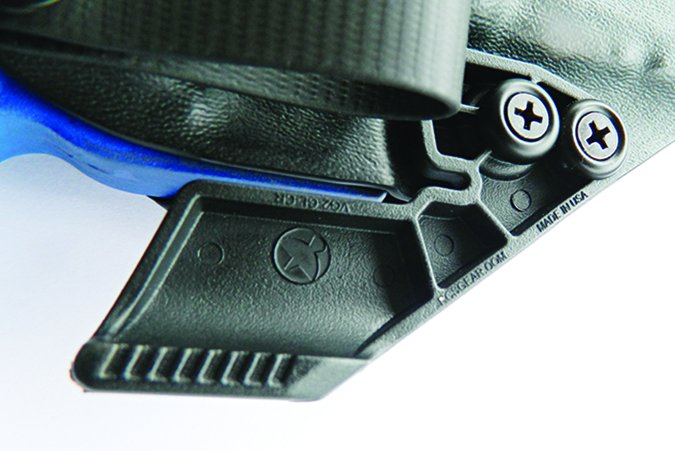
There is a tendency of the handgun to shift forward, away from the body, in appendix carry. This device prevents that roll-out and keeps the holster tight against the body. There is also a body shield behind the handgun, sometimes called a sweat guard. We like a holster that insulates the body from the handgun. This holster does that. This JM Custom Kydex holster also eliminates roll-out or canting from the body, which limits some AIWB holsters. As the raters evaluated this holster, we found no drawbacks and no trade-offs. It also works as well as a standard IWB due to the belt loop’s ability to be adjusted, and with removal of the claw. This is a tactically superior holster offered at a fair price.
Keepers Concealment Errand, $90
GUN TEST GRADE: A
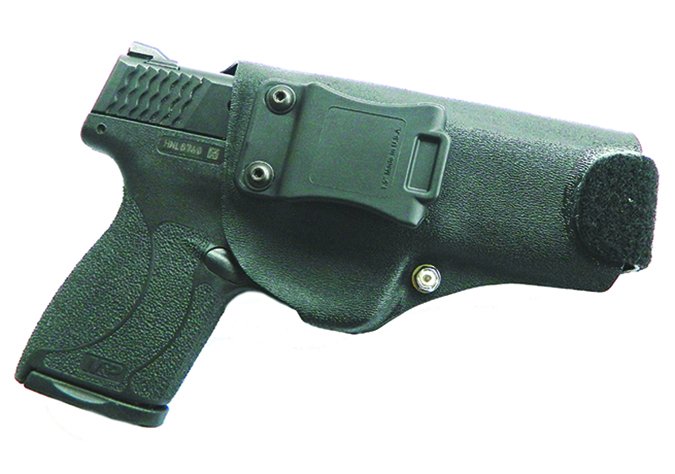
This holster is available from KeepersConcealment.com. The Keepers Errand is billed as a holster for faster on and off use, such as when you are running an errand, yet it is said to be capable for all-day use as well. The Errand has a sweat guard, a durable clip-on belt attachment with a hook that securely locks on the belt, and a Velcro attachment point. The holster is supplied with two foam wedges. Out of the box, retention was correctly set, and the holster passed the drop test handily, with all raters taking a turn shaking the pistol. However, the draw was sharper with this holster than with the Keepers holster reviewed below. After testing the Errand extensively, we find a credible holster well worth the price.
While the other Keepers holster would be a good choice for some, three of four of the raters prefer the Errand over the more expensive holster and would even stay with the Errand if each were the same price. We feel that the Errand’s added expense over some tested is well justified by the Velcro addition and the wedges that add to both comfort and roll-out prevention. It is among the top holsters tested.
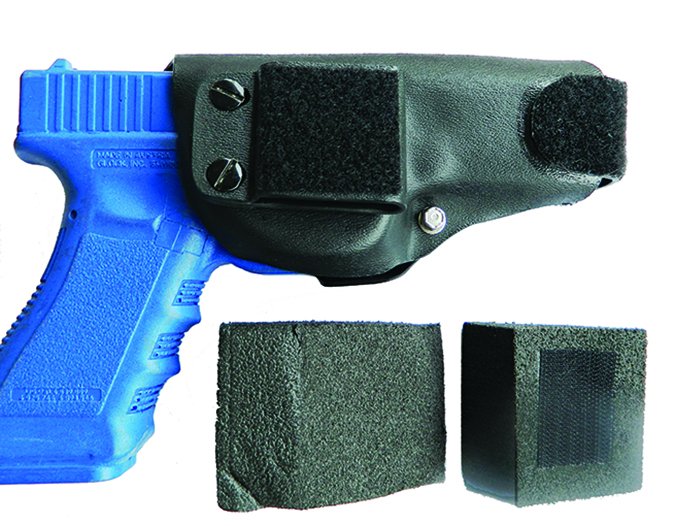
Keepers Concealment The Keeper AIWB, $170
GUN TEST GRADE: B
The Keeper is a holster with many good features, and it is also the most expensive holster tested. The holster has the appearance of a bulky holster at first glance, but it isn’t. It actually follows the lines of the handgun closely. The holster features a very solid attachment point consisting of a tunnel loop. While more time is needed to thread the belt through a tunnel loop versus a snap-on belt attachment, this is clearly the superior method for retention. The holster features a sweat guard to separate the handgun from the body.
The belt loop is covered with Velcro, and more important, a long Velcro attachment runs from the front to the rear of the holster. A tension screw allows good adjustment for the draw and retention of the handgun. A bit of rocking and a strong tug are required to draw the pistol. The Keeper demands a strong tug and much practice for the draw. For most shooters, this system may be too complicated.
Written and photographed by Gun Tests staff.


























